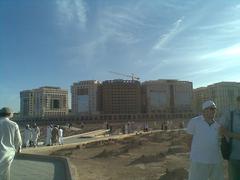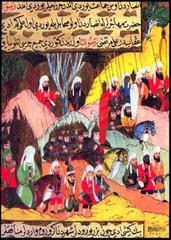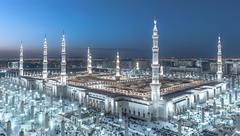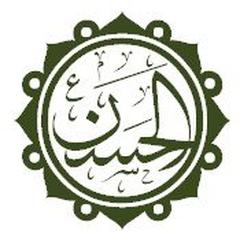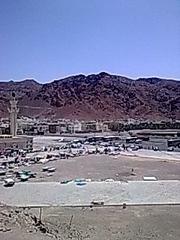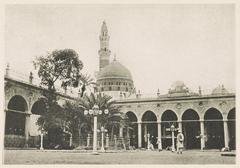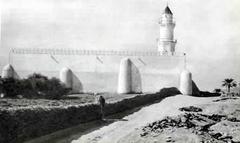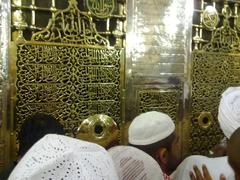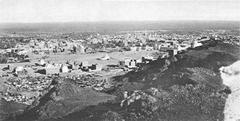Masjid Al-Qiblatain Visiting Hours, Tickets & Medina Historical Sites Guide
Date: 14/06/2025
Introduction
Masjid Al-Qiblatain, or the “Mosque of the Two Qiblas,” is one of Medina’s most spiritually significant landmarks. It marks the moment in Islamic history when the direction of prayer (qibla) changed from Jerusalem to Mecca, as revealed to Prophet Muhammad (ﷺ). This pivotal event is commemorated within the mosque, making it a vital destination for pilgrims and history enthusiasts. This comprehensive guide details Masjid Al-Qiblatain’s historical background, religious significance, visiting hours, accessibility, travel tips, guided tours, and nearby Medina historical sites, ensuring you make the most of your visit (Islamic Landmarks; About Islam; WelcomeSaudi).
Table of Contents
- Historical and Religious Significance
- Practical Visitor Information
- Cultural Insights & Local Experiences
- Frequently Asked Questions (FAQ)
- Conclusion & Call to Action
- References
Historical and Religious Significance
Early Foundations and Construction
Masjid Al-Qiblatain was constructed in 2 AH (624 CE) by Sawad bin Ghanam bin Kaab, a devoted companion of the Prophet Muhammad (ﷺ) (Islamic Landmarks). The original mosque was a modest building with local materials, reflecting the simplicity of early Islamic architecture.
The Qibla Change
A defining event occurred in Rajab, 2 AH (624 CE), during a Dhuhr prayer led by the Prophet (ﷺ). He received a revelation instructing him to change the qibla from Jerusalem to Mecca:
“We have certainly seen the turning of your face, [O Muhammad], toward the heaven, and We will surely turn you to a qibla with which you will be pleased. So turn your face toward al-Masjid al-Haram…” (Quran 2:144)
The Prophet (ﷺ) turned mid-prayer, and his companions followed, leading to the mosque’s unique identity (About Islam). Historically, the mosque featured two mihrabs—one facing Jerusalem (now covered) and the other facing Mecca, symbolizing this spiritual transition.
Architectural Evolution
Masjid Al-Qiblatain has seen several renovations throughout history. The most significant transformation occurred in 1987, when the Saudi government expanded and modernized the mosque. The Jerusalem-facing mihrab was removed, but its location is still marked, preserving the mosque’s historical narrative (WelcomeSaudi). The mosque now features spacious halls, two prominent domes, elegant minarets, and enhanced facilities for visitors.
Practical Visitor Information
Visiting Hours & Entry
- Open: 24 hours a day, seven days a week, to accommodate worshippers and visitors.
- Entry Fee: None. Entry is free for all.
- Best Times to Visit: Early morning or late afternoon for a quieter experience; evenings offer a beautifully illuminated ambiance.
- Peak Periods: Fridays, Ramadan, and Hajj season are busiest; plan accordingly (TravelSetu).
Dress Code & Etiquette
- Men: Long trousers, sleeved shirts.
- Women: Abaya and headscarf.
- General: Shoes must be removed before entering prayer halls. Maintain silence, avoid photography during prayers, and respect the sanctity of the mosque (TravelSetu).
Facilities & Accessibility
- Prayer Halls: Separate areas for men and women, air-conditioned, and spacious.
- Ablution Areas: Modern, clean, and accessible.
- Accessibility: Wheelchair ramps, elevators, and accessible washrooms are provided.
- Other Amenities: Restrooms, drinking water stations, and a residential block for mosque staff (Onedayhit).
Guided Tours & Travel Tips
- Guided Tours: Available through local tour operators and hotels. Recommended for deeper historical and religious context (TravelSetu).
- Travel Tips:
- Combine with visits to Al-Masjid an-Nabawi and Quba Mosque.
- Taxis and ride-hailing apps are widely available. Local buses also serve the area.
- Visit between prayer times for fewer crowds.
- Bring a reusable water bottle and comfortable shoes.
- English is widely spoken among staff and guides.
- Safety: Security is a high priority. Staff are available for assistance (Onedayhit).
Nearby Attractions
- Al-Masjid an-Nabawi: The Prophet’s Mosque, second holiest site in Islam (Visit Al Madinah).
- Quba Mosque: The first mosque in Islam, known for its tranquility.
- Mount Uhud: Historic battlefield site.
- Jannat al-Baqi: The oldest and most significant cemetery in Medina.
- Masjid Al-Ghamamah: Site associated with the Prophet’s prayers for rain.
- Koran Museum: Rare manuscripts and exhibits.
- Rashed Mall: Shopping and dining options (Agoda; Rehlat).
Visuals & Media
- Maps and virtual tours are available via trusted travel platforms.
- High-quality photos: exterior view, prayer hall, mihrab, and domes.
- Use alt tags such as “Masjid Al-Qiblatain Medina,” “Historical sites in Medina.”
Cultural Insights & Local Experiences
- Spiritual Significance: The mosque’s unique history offers a tranquil space for prayer and reflection (Onedayhit).
- Local Customs: Modest dress, respectful behavior, and observing local etiquette are essential.
- Festivals: Special events and lectures are held during Ramadan and Islamic holidays.
- Culinary Experiences: Try Medina’s famous dates and Arabic coffee at nearby cafés (Audiala).
- Shopping: Visit local souks for traditional goods or Rashed Mall for modern amenities.
- Best Visiting Season: October to March is cooler and more comfortable for sightseeing (Agoda).
Frequently Asked Questions (FAQ)
Q: What are the visiting hours for Masjid Al-Qiblatain?
A: The mosque is open 24 hours daily.
Q: Is there an entry fee or ticket required?
A: No, entry is free for all visitors.
Q: Are non-Muslims allowed inside?
A: Non-Muslims are generally not permitted inside the mosque.
Q: Are guided tours available?
A: Yes, through local agencies and hotels.
Q: Is the mosque accessible for people with disabilities?
A: Yes, it has ramps, elevators, and wide corridors.
Q: Is photography allowed?
A: Yes, outside prayer times and in non-restricted areas. Always seek permission before photographing worshippers.
Conclusion & Call to Action
Masjid Al-Qiblatain stands as a living testament to a transformative moment in Islamic history. Its unique architectural legacy, open accessibility, and spiritual atmosphere make it a must-visit for anyone exploring Medina’s religious and cultural landscape. Combine your visit with nearby historical sites for a richer experience, and always respect the sanctity of these sacred places (Islamic Landmarks; WelcomeSaudi).
For up-to-date information, interactive maps, and more, download the Audiala app and follow us on social media. Start your journey through Medina’s historical and spiritual heritage today.
References
- Islamic Landmarks – Masjid Al-Qiblatain
- About Islam – The Story of the Mosque of Two Qiblahs
- WelcomeSaudi – Masjid Al-Qiblatayn
- TravelSetu – Things to Do in Qiblatain Mosque
- Visit Al Madinah – How to Visit Medina
- HalalTrip – Masjid Al-Qiblatain
- Agoda – Majestic Mosques in Medina
- Rehlat – Masjid Al-Qiblatayn
- Audiala – Medina Travel Guide
- Onedayhit – Masjid Qiblatain History
